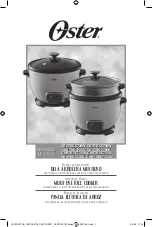
46
Poultry
The weights indicated in the table refer to oven-ready poultry
(without stuffing).
Place whole poultry on the lower wire rack breast-side down.
Turn after
Z
of the specified time.
Turn roasts, such as rolled turkey joint or turkey breast, halfway
through the cooking time. Turn poultry portions after
Z
of the
time.
For duck or goose, pierce the skin on the underside of the
wings. This allows the fat to run out.
Poultry will turn out particularly crispy and brown if you baste it
towards the end of the roasting time with butter, salted water or
orange juice.
If you are grilling directly on the wire rack, you should insert the
baking tray at level 1. The meat juices are collected in the pan
and the oven is kept cleaner.
Fish
Turn the pieces of fish after
Z
of the grilling time.
Whole fish does not have to be turned. Place the whole fish in
the oven in its swimming position with its dorsal fin facing
upwards. Placing half a potato or a small ovenproof container
in the belly of the fish will make it more stable.
If you are grilling directly on the wire rack, you should also
insert the baking tray at level 1. The liquid is then collected,
keeping the oven cleaner.
Grilling with the rotary spit
The rotary spit is particularly good for cooking large roasts,
such as rolled roasting joints or poultry. The meat becomes
crispy and brown.
Tips for roasting and grilling
Poultry
Weight
Accessories and
ovenware
Level
Type of
heating
Temperature in
°C
Cooking time
in minutes
Chicken, half
400 g each Wire rack
2
%
210-230
50-60
Chicken pieces
250 g each Wire rack
2
%
210-230
30-40
Chicken, whole
1.0 kg
Wire rack
2
%
210-230
60-80
Duck, whole
1.7 kg
Wire rack
2
%
200-220
90-100
Goose, whole
3.0 kg
Wire rack
2
%
190-210
100-120
Small turkey, whole
3.0 kg
Wire rack
2
%
200-220
80-100
2 turkey drumsticks
800 g each Wire rack
2
%
200-220
100-120
Fish
Weight
Accessories and
ovenware
Level
Type of
heating
Temperature in
°C, grill setting
Cooking time
in minutes
Fish, whole
300 g each
Wire rack
3
(
2
20-25
1.0 kg
Wire rack
2
%
190-210
45-50
1.5 kg
Wire rack
2
%
180-200
50-60
Fish fillet, 3 cm
300 g each
Wire rack
4
(
2
20-25
Dish
Weight
Accessories and ovenware Level
Type of
heating
Temperature in
°C, grill setting
Cooking time
in minutes
Meat
Spit-roasted joint
1.0 kg
Rotary spit
1
E
220-240
110-130
Poultry
Chicken
1.5 kg
Rotary spit
1
E
240-250
70-90
Duck
2.0 kg
Rotary spit
1
E
240-250
80-100
The table does not contain information
for the weight of the joint.
Select the next lowest weight from the instructions and extend the time.
How to tell when the roast is ready.
Use a meat thermometer (available from specialist shops) or carry out a “spoon test”.
Press down on the roast with a spoon. If it feels firm, it is ready. If the spoon can be
pressed in, it needs to be cooked for a little longer.
The roast is too dark and the crackling
is partly burnt.
Check the shelf height and temperature.
The roast looks good but the juices are
burnt.
Next time, use a smaller roasting dish or add more liquid.
The roast looks good but the juices are
too clear and watery.
Next time, use a larger roasting dish and use less liquid.
Steam rises from the roast when basted. This is normal and due to the laws of physics. The majority of the steam escapes through
the steam outlet. It may settle and form condensation on the cooler switch panel or on
the fronts of adjacent units.
















































